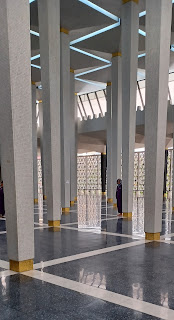There is no doubt that the heat and humidity impacted our visit to Malaysia's capital, Kuala Lumpur. In addition to making extended walking difficult, it limited our desire to take pictures given how we looked after even a short walk. We also found that although KL had significant public transit options, they often did not connect well and ended up reducing our required walking time by very little.
Nonetheless, as is often the case for us "city mice", we did enjoy exploring the city, seeing some of the sites, and learning some of the history of both KL and Malaysia. One of the classic old buildings in the city is the Sultan Abdul Samad building (left and bottom photos below), which was built in the 1890's during the British occupation, and has been a government building since then. The photo on the right is the Jamek Mosque, which is built at the confluence of KL's two rivers (the Klang and the Gombek), where the early residents of the city are believed to have settled. This was the primary mosque in KL from the early 1900's until the building of the National Mosque. We particularly like this picture of the mosque because of how it demostrates the old and the new of KL.
We visited the National Mosque, which was opened in 1965, only 8 years after Malaysia declared independence from the British Empire. It is beautiful.
All of the mosques that tourists visit offer the type of robe that Shana is wearing so that visitors can see the mosque while dressing in compliance with Muslim religious rules (they have hoods to ensure that women can cover their heads, but Shana carried her own scarf for just this purpose).
We visited the city's Islamic Art Museum, which we found absolutely fascinating (unfortunately, no photos were allowed inside). Since Islam does not permit the depiction of sentient beings (at least for religious purposes), most Islamic art uses caligraphy. In more recent times, Arabic script is often used to create more abstract and even surreal art. In fact, in many cases, if you didn't know, you wouldn't realize that the paintings were examples of Islamic art.
In addition to the modern Islamic paintings, the museum had historical items that allowed us to learn more about Islamic history; and, one of our favorite exhibits was of various scale models of mosques from around the world. My personal favorite was a mosque in Pakistan that has a courtyard with sufficient space for 100,000 (!) people to pray at one time. That would be something to see.
Perhaps the most fascinating site we visited in KL was the Batu Caves. These caves are located north of the city and we were able to catch a train directly there. We went early to try to beat the tourist crowds (which we did), but we did not beat the Thaipusam crowds, which were enormous!
So, what is Thaipusam, and why did it bring huge crowds? Well, the caves include various Hindu temples built starting in the 1890's. The primary temple is dedicated to Lord Murugan and his primary festival is Thaipusam, which takes place in late January or early February -- this year January 25. We were fortunate that we were not there on the actual day, but even a week before, it was crazy.
The giant statue of course is Lord Muguran, and the mass of humanity on the left are people going up to his temple to make their offering. Most wear yellow (his favorite color) and carry their offering (generally milk) in a small jug on their head.













No comments:
Post a Comment